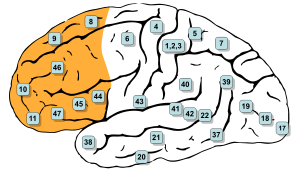| Prefrontal cortex | |
|---|---|
 Brodmann areas, 8, 9, 10, 11, 12, 13, 14, 24, 25, 32, 44, 45, 46, and 47 are all in the prefrontal cortex[1] | |
| Details | |
| Part of | Frontal lobe |
| Parts | Superior frontal gyrus Middle frontal gyrus Inferior frontal gyrus |
| Artery | Anterior cerebral Middle cerebral |
| Vein | Superior sagittal sinus |
| Identifiers | |
| Latin | cortex praefrontalis |
| MeSH | D017397 |
| NeuroNames | 2429 |
| NeuroLex ID | nlx_anat_090801, ilx_0109209 |
| FMA | 224850 |
| Anatomical terms of neuroanatomy | |
In mammalian brain anatomy, the prefrontal cortex (PFC) covers the front part of the frontal lobe of the cerebral cortex. It is the association cortex in the frontal lobe.[2] The PFC contains the Brodmann areas BA8, BA9, BA10, BA11, BA12, BA13, BA14, BA24, BA25, BA32, BA44, BA45, BA46, and BA47.[1]
This brain region is involved in a wide range of higher-order cognitive functions, including speech formation (Broca's area), gaze (frontal eye fields), working memory (dorsolateral prefrontal cortex), and risk processing (e.g. ventromedial prefrontal cortex). The basic activity of this brain region is considered to be orchestration of thoughts and actions in accordance with internal goals.[3] Many authors have indicated an integral link between a person's will to live, personality, and the functions of the prefrontal cortex.[4]
This brain region has been implicated in executive functions, such as planning, decision making, working memory, personality expression, moderating social behavior and controlling certain aspects of speech and language.[5][6][7][8] Executive function relates to abilities to differentiate among conflicting thoughts, determine good and bad, better and best, same and different, future consequences of current activities, working toward a defined goal, prediction of outcomes, expectation based on actions, and social "control" (the ability to suppress urges that, if not suppressed, could lead to socially unacceptable outcomes).
The frontal cortex supports concrete rule learning, with more anterior regions supporting rule learning at higher levels of abstraction.[9]
- ^ a b Murray E, Wise S, Grahatle K (2016). "Chapter 1: The History of Memory Systems". The Evolution of Memory Systems: Ancestors, Anatomy, and Adaptations (1st ed.). Oxford University Press. pp. 22–24. ISBN 978-0-19-150995-7. Retrieved 12 March 2017.
- ^ "Prefrontal Cortex - an overview | ScienceDirect Topics". www.sciencedirect.com. Retrieved 2024-02-08.
- ^ Miller EK, Freedman DJ, Wallis JD (August 2002). "The prefrontal cortex: categories, concepts and cognition". Philosophical Transactions of the Royal Society of London. Series B, Biological Sciences. 357 (1424): 1123–1136. doi:10.1098/rstb.2002.1099. PMC 1693009. PMID 12217179.
- ^ DeYoung CG, Hirsh JB, Shane MS, Papademetris X, Rajeevan N, Gray JR (June 2010). "Testing predictions from personality neuroscience. Brain structure and the big five". Psychological Science. 21 (6): 820–828. doi:10.1177/0956797610370159. PMC 3049165. PMID 20435951.
- ^ João, Rafael Batista; Filgueiras, Raquel Mattos (2018-10-03), Starcevic, Ana; Filipovic, Branislav (eds.), "Frontal Lobe: Functional Neuroanatomy of Its Circuitry and Related Disconnection Syndromes", Prefrontal Cortex, InTech, doi:10.5772/intechopen.79571, ISBN 978-1-78923-903-4, retrieved 2023-06-24
- ^ Yang Y, Raine A (November 2009). "Prefrontal structural and functional brain imaging findings in antisocial, violent, and psychopathic individuals: a meta-analysis". Psychiatry Research. 174 (2): 81–88. doi:10.1016/j.pscychresns.2009.03.012. PMC 2784035. PMID 19833485.
- ^ Gabrieli JD, Poldrack RA, Desmond JE (February 1998). "The role of left prefrontal cortex in language and memory". Proceedings of the National Academy of Sciences of the United States of America. 95 (3): 906–913. Bibcode:1998PNAS...95..906G. doi:10.1073/pnas.95.3.906. PMC 33815. PMID 9448258.
- ^ Baldauf D, Desimone R (April 2014). "Neural mechanisms of object-based attention". Science. 344 (6182): 424–427. Bibcode:2014Sci...344..424B. doi:10.1126/science.1247003. PMID 24763592. S2CID 34728448.
- ^ Badre D, Kayser AS, D'Esposito M (April 2010). "Frontal cortex and the discovery of abstract action rules". Neuron. 66 (2): 315–326. doi:10.1016/j.neuron.2010.03.025. PMC 2990347. PMID 20435006.